This new class (Digital Fabric Printing) will be available at http://QuiltUniversity.com and begins September 8th, 2007.
It is a class for quilters and other designers who love fabric and designs that tile (repeat seamlessly) across a surface. we will design from scratch with a very simple approach and we will use a variety of free or inexpensive computer programs to make patterns too.
If you can do it in your computer or if you can photograph or scan it into your computer, it can be printed on fabric. the class also includes basic techniques for printing on fabric and for modifying your computer images. That is a lot of ground to cover, but it is a world of fun.
I've been playing with a new beta version of the program Kaleider mentioned in my last post here. It will be Vista ready and has a nice new surprise that I think appliquers in particular will find exciting. I'll keep you posted...
Tuesday, August 07, 2007
Friday, February 23, 2007
Back again



Blogs need pictures so (if I can figure out how to do it on this new blogger system) I'll add a few of a jillion or so seamless tiles I have accumulated for the class I'm currently prreparing about printing digital fabric on home office printers. These three small seamless tiles were made from a single fractal image. The larger image at the side shows how it repeats as a fabric. Whooie! am I having fun!
Well, it has been a very busy year, complicated greatly by some insidious and severe side effects from taking a statin drug for cholesterol control. Suffice it to say that when I went off the drug a few months ago my cholesterol level went back down to low normal. I've made some fairly minor life style changes as well, so it is difficult to say exactly what caused what.
But that was last year, and this is a new one and I am back. I'm busy writing new classes for Quilt University--which, as usual, means that I am finding more things I still need to learn. I have a new digital video camera because I want to do some video clips for teaching. I know art, and I know photography--but video is another breed of cat. I know that one cannot turn the video camera to take vertical shots, and I'm still learning that you are supposed to talk to the bloomin' thing. Which leads to an area where I am really in over my head--audio--but as usual, I will learn.
I've also learned not to trust the manual for this camera. I lost all my shots of our disastrous ice storm a month ago because I didn't download them to my computer properly. At the very end, in very tiny print, and in the middle of a long list of very tiny print items, was a statement that if you didn't download them properly, you wouldn't be able to open them. That should have been in big print at the very beginning of the directions for downloading. It is my own fault, of course, but it does help a bit to to blame a poorly prepared manual.
Friday, March 24, 2006
Art quilters--who, what, why?
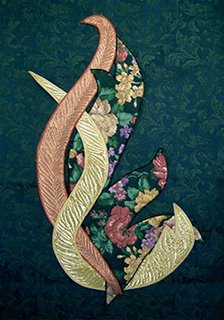
Art quilts? What are they, what makes them "art"?
That question can get you into some really intense discussions, so I'll take the easy way out and for now, simply say that art quilts are quilts made by quilt artists.
Which, of course, leads to more questions...
What is as an "quilt artist"? How do you get to be one? Why in the world would you want to be one? I have three personal definitions in answer to questions like this. They say essentially the same thing in three different ways. So take your pick--or ignore the whole thing-- but each definition has its own part of my story.
Definition One:
I grew up in a home where curiosity, creativity, making stuff, figuring things out, experimenting, exploring were all simply taken for granted. That is how we did things. The one thing we didn't get was any sense that this was special. We were different--and different was often a very uncomfortable thing to be.
So I was past thirty before it ever entered my head that I could be an artist--or that I could even try. Being an artist, like music, dance, acting, writing--those were things that special people--special people with talent-- could do, not ordinary people like me.
So there is the first definition: An art quilter is an ordinary quilter who has discovered an extra-ordinary secret--that it is OK to play in the No-rules Zone! (and my profound thanks to whoever first used that last phrase.)
A few years after I discovered this, I went back to college for my art training because I knew that was what I wanted to be teaching. Sitting in the hole-in-the-wall where commuting students waitied for their next class, we were talking one day about what we would do when we graduated. I said that I had a job teaching art in my local school system. One young thing cocked her head, looked me up and down and said, "You don't look like an art teacher!" Of course not--I'm pretty ordinary. I am also an artist (and a musician, dancer, actor and writer...)
Definition Two:
When I began teaching art I learned three things very quickly.
1. I knew nothing whatever about teaching creativity. We had never even discussed the matter in my art classes.
2. Teaching creativity was the last thing my school wanted of me. They had enough trouble with kids' creative impulses without my encouraging them. Now if they had thought it would have helped them win another football game...
3. They had no intention of letting me teach creatively. My principal (a former coach) even told me that we should be doing things like lacing leather billfolds.
This started me on what has been an almost forty year study of creativity. The definition of creativity that I formulated for myself back then is still valid and my second definition: An art quilter makes art by adding something of herself.
A few years ago my husband was in a nursing home and I was spending a good part of each day helping with his care. I took a few days off to go the the AQS show in Paducah. It was a zoo and by Sunday morning I had had people up to here. Halfway home, I decided that I couldn't stand the rest of the long drive home so I turned off, found a National Forest campground and spent the rest of the afternoon and evening in blessed quiet and solitude.
Since the only camping gear I had with me was a sleeping pad and it looked like it could rain, I decided to sleep in the rear of my little Subaru station wagon. Its doable if I sleep catty-wumpus, but it is definitely an adventure. Early the next morning I drove the rest of the way home.
That afternoon we had a caregivers' support group meeting. The first activity was to recount how we had spent the previous 24 hours. I explained where I had been and where I had spent the night. The woman in charge looked me, shook her head and said, "Only you, Lily, only you!"
That "Only you" factor is the hallmark of the art quilter.
Definition Three:
In my August blog, I wrote about the way this third definition works. The photo above is that "I Lead Three Lives" quilt. Whether you choose to follow directions, ignore them completely or work around them, find loopholes, stretch and redefine the rules, the art quilter is a possibility thinker. So definition three is this:
The art quilter looks at what everyone else is looking at and sees possibilities no one else is seeing.
Possibility thinking is always a journey of experimenting and discovery. It is always an adventure. If you have found this kind of excitement (and it has nothing whatever to do with your skill level) in making your quilt, then in my book you are entitled to call that quilt an art quilt and yourself an art quilter.
ArtQuilts
The problem with giving a quilt a label like Art, Not-Art, Good Art, Bad Art or any other label is that we are really talking about three different things--and they can be quite different.
In the middle is the Thing--the assemblage of fabric and stuff. It just is. You can give it any label you choose and that doesn't change it. It's a "rose by any other name..." kind of thing.
On one side is the artist and the experience of creating it. Only the artist can give her quilt a label from that direction. On the other side, is the viewer's experience of that quilt and the viewer is equally entitled to give the quilt a label based on the experience of viewing that quilt.
My personal definition, as a viewer, of an art quilt is this:
If your quilt grabs me, if it intrigues me, makes me want to touch it or ask questions about it, if it involves me, then I am happy to call it an art quilt and salute you as the artist. If you tell me the story of your adventure, I will do the same.
Oh yes, there was another question: Why am I an art quilter? I'm an art quilter because those skills are part of my heritage as a human being--and because I have chosen to use them.
Friday, January 06, 2006
One Track Mind

I'm not sure that what I have is a one-track mind or what, but when I get involved with something I sure hate to quit. I've been known to stay up until the wee hours to finish a good book. When I was doing a lot of acrylic painting, I preferred to have a whole day and a half at least to work, ignoring everything else (or as nearly as possible considering that I had 4 kids.) If I stopped and came back later, nothing went right, the new set of colors were not right and the inspiration was gone.
Aging hasn't changed that. I can get lost in playing with my computer graphics or designing a quilt or dyeing fabric or playing with polymer clay or writing lessons. Now that I am alone (after 39 years of marriage) I find that I can indulge that tendency--but once in a while, the outside world intrudes... I'm taking off this afternoon to make hospital calls.
I've just spent the last few days playing with a new version of a fractal program, wmPHoto. This program is unusual in that it uses your own photos for the coloring of the fractal shapes created by the program. That makes for a lot of experimenting, but when everything comes together, the results can be both unusual and exhilerating. I have a multitude of photos, a jillion or so fractal images made in the program Apophysis and a couple jillion of those that were post-processed through Kaleider. I've only begun to explore all these in wmPHoto. I think I need at least a couple more lifetimes!
In this wmPHoto image you can probably recognize a photo of a dandelion and perhaps the other one which is just a single dried leaf hanging from a twig. Why use a computer? I probably would never have thought of this combination of shapes and colors on my own. But it still takes an artist's eye to recognize and modify to get an artist's image. My computer is a tool that makes exploration of ideas and possibilities a true adventure.
I guess it is no wonder that one gets involved when you come across a set of shapes and colors that are not only satisfying, but infinitely variable. But then, isn't that what this whole art thing is about?
Oh yes, before you ask, you can find the wmPHoto fractal program here in the files section: http://groups.yahoo.com/group/wmPHoto/messages
Kaleider here: http://www.whizical.com
And Apophysis here: http://sourceforge.net/project/showfiles.php?group_id=127736
and Apo tutorials here: http://www.thefractalfarm.net/
Just a word of warning--fractals are highly addictive!
Sunday, December 11, 2005
Christmas Greetings

I've been part of the children's Christmas program at church this year. In their play, my part was to tell them a story about what Christmas was like when I was a kid. Rather than tell them the same story every time we rehearsed, I told them a different "practice" story each time. What fun--and what memories!
The years change and so do we--but Christmas is still Christmas. The story we celebrate is still the same. And so I wish for you my friends, personal and virtual, the richest blessings of this joyous season.
Tuesday, September 06, 2005
Answering fractal questions..
I've been getting a lot of questions about how these images were made, so here is a bit of generic information.
Fractals are patterns of repetition that are self-similar at any scale. Trees--leaves, branches, roots-- are fractal because they share similar patterns no matter how small or large the tree. A spiral is a fractal pattern whether you are looking at DNA, a snail shell or a galaxy. There are many other things that have fractal qualities, ranging from music to economic growth.
There are a variety of programs that create beautiful and very complex images based on mathematical patterns. These are available for download on the web. Most are free or fairly inexpensive. A search for "fractal images" will give you links to all kinds of sites with fractals. A search for "fractal programs" or "fractal generators" will give you links to a wide variety of sites that either have downloads or links to downloads.
These are image generating programs, not image manipulation programs
(like Photoshop or Print Shop Pro.) When you select various combinations
of possibilities from drop down menus, the programs generate one or
more images based on the information you have given it. Most programs
also have options for modifying either the image and/or the ways colors
are applied. The majority of the programs are Windows based.
The two programs I used for the fractals on my blog are Vchira and
Tierazon, which you can find by searching either for them or for Stephen
Ferguson who is their author. These are both quite easy to use, although
Tierazon is more complex. Just ignore anything that asks for a number
until you are comfortable with playing with the program.
Fractal Forge and Fractal Explorer are other fairly simple ones. UltraFractal (not free) is one of the best available. Apophysis is very simple for beginners, but complex if you want to learn to master it. It creates a different kind of fractal than the others mentioned. I do not recommend the program Fractint for beginners, however, unless you have a very strong math background. (Besides it is DOS based.)
If you download a program, don't forget that there are usually help files, often online tutorials and/or forums.
I teach a class that is an overview of fractals and their possibilities
as a design resource. The next session opens the first of October at
http://QuiltUniversity.com
I've also opened a Yahoo group
http://groups.yahoo.com/group/fractal-quilters/ as a place to talk with
others who are using fractals as a design resource. It is a varied
group--experienced and beginner quilters, fractal beginners and experienced fractalists, mathematicians and math-handicapped. There are also several needleworkers in other media.
Fractals are a very big subject. But be warned. It is very easy to get hooked!
Fractals are patterns of repetition that are self-similar at any scale. Trees--leaves, branches, roots-- are fractal because they share similar patterns no matter how small or large the tree. A spiral is a fractal pattern whether you are looking at DNA, a snail shell or a galaxy. There are many other things that have fractal qualities, ranging from music to economic growth.
There are a variety of programs that create beautiful and very complex images based on mathematical patterns. These are available for download on the web. Most are free or fairly inexpensive. A search for "fractal images" will give you links to all kinds of sites with fractals. A search for "fractal programs" or "fractal generators" will give you links to a wide variety of sites that either have downloads or links to downloads.
These are image generating programs, not image manipulation programs
(like Photoshop or Print Shop Pro.) When you select various combinations
of possibilities from drop down menus, the programs generate one or
more images based on the information you have given it. Most programs
also have options for modifying either the image and/or the ways colors
are applied. The majority of the programs are Windows based.
The two programs I used for the fractals on my blog are Vchira and
Tierazon, which you can find by searching either for them or for Stephen
Ferguson who is their author. These are both quite easy to use, although
Tierazon is more complex. Just ignore anything that asks for a number
until you are comfortable with playing with the program.
Fractal Forge and Fractal Explorer are other fairly simple ones. UltraFractal (not free) is one of the best available. Apophysis is very simple for beginners, but complex if you want to learn to master it. It creates a different kind of fractal than the others mentioned. I do not recommend the program Fractint for beginners, however, unless you have a very strong math background. (Besides it is DOS based.)
If you download a program, don't forget that there are usually help files, often online tutorials and/or forums.
I teach a class that is an overview of fractals and their possibilities
as a design resource. The next session opens the first of October at
http://QuiltUniversity.com
I've also opened a Yahoo group
http://groups.yahoo.com/group/fractal-quilters/ as a place to talk with
others who are using fractals as a design resource. It is a varied
group--experienced and beginner quilters, fractal beginners and experienced fractalists, mathematicians and math-handicapped. There are also several needleworkers in other media.
Fractals are a very big subject. But be warned. It is very easy to get hooked!
Monday, September 05, 2005
Katrina images
Isn't the mind a remarkable thing! About a week ago I had made a couple dozen images in the fractal generating programs, Vchira and Tierazon. They didn't seem to be anything remarkable although probably worth saving.
In going through some images I looked at these again and was struck by some of them which reminded me very strongly of what we have been seeing on the TV this past week.
These images are unchanged except for resizing and a bit of contrast enhancement afterwards.
If you can use a larger image of these in any way, please email me (Katrina images zip as the subject) and I will send them to you as a large zip file (PhotoShop .psd or .tif files.) Just make a donation to the Katrina charity of your choice. Better yet, make it somewhere that is matching funds...
I am posting the images below.
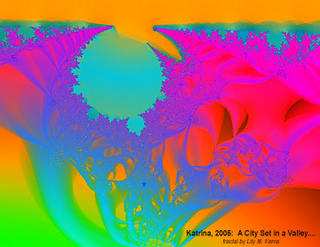
New Orleans
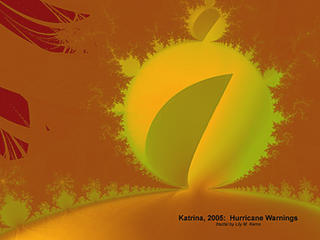
Hurricane Warnings!

The Big Easy

Category Four
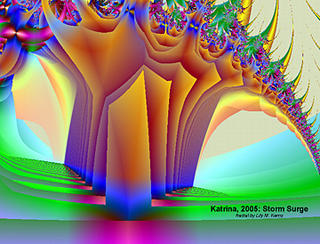
Storm Surge
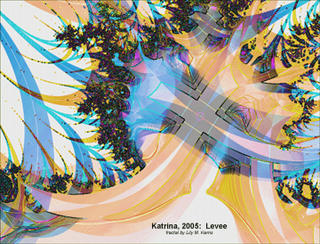
Levee
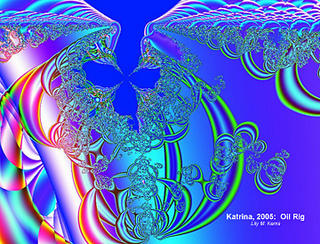
Oil Rig

Superdome
In going through some images I looked at these again and was struck by some of them which reminded me very strongly of what we have been seeing on the TV this past week.
These images are unchanged except for resizing and a bit of contrast enhancement afterwards.
If you can use a larger image of these in any way, please email me (Katrina images zip as the subject) and I will send them to you as a large zip file (PhotoShop .psd or .tif files.) Just make a donation to the Katrina charity of your choice. Better yet, make it somewhere that is matching funds...
I am posting the images below.

New Orleans

Hurricane Warnings!

The Big Easy

Category Four

Storm Surge

Levee

Oil Rig

Superdome
Subscribe to:
Comments (Atom)